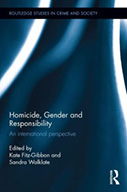Homicide, Gender and Responsibility: An International Perspective

Editors: Kate Fitz-Gibbon and Sandra Walklate
Publisher: London; New York: Routledge, 2016. 184p.
Reviewers: Eleonora Rossi and Marieke Liem | May 2017
Fitz-Gibbon and Walklate’s collection is organized in two parts, each consisting of four short chapters. The overall aim of this edited volume is to cast light on ‘how gendered understandings and experiences of violence permeate representations of responsibility’ (p.3). Responsibility is intended as a synonym of accountability, in legal as well as moral terms. The authors build on Kelly’s (1988) and Cockburn’s (2009) concept of a ‘continuum of violence’ to argue that a gendered analysis of lethal violence should not be limited to the usual ‘private’ and ‘domestic’ sphere, but should be extended to the ‘public’ world of states, corporations, war and genocide. While the first part of the book is dedicated to the overlapping categories of domestic and intimate partner homicide, as well as child-perpetrated homicide, the second part focuses on less explored contexts, such as lethal violence in armed conflict, murder cases dealt with under international law, deaths in state-owned detention centres, and corporate manslaughter.
The book provides an interesting perspective on questions of culpability and the legal responses to homicide by showing how divergent representations of victims and offenders result in divergent representations of responsibility. The attempt to explain the role of gender in these representations and to study the gendered dimension in a range of different contexts of lethal violence should be applauded. However, in spite of the title of the book, a gendered perspective remains virtually absent in the last three chapters. This is in stark contrast to the chapters on domestic and intimate partner homicide, child-perpetrated and war-related homicides, where the role of gender is discussed extensively. For example, Chapter six only touches upon the fact that sex-selective war violence that targets boys and men should be considered gender-based, and that sexual violence against men is often represented by defence counsels at ICTY as ‘political and tactical’, whereas sexual violence against women is represented as ‘the acting out of urges, hence not related to politics’ (p.127). Here, the role of gender is mentioned, but remains unaddressed in depth. Similarly, Chapter seven only slightly touches on the notion of gender when referring to the harsh conditions of Manus Island detention centre that were not considered suitable for families and children and that the change to a single adult male-only facility ‘increased likelihood of tensions leading to violence’ (p.136). Finally, Chapter eight briefly points out that there is a strong gender difference in the workplace fatality incidence rates in EU15 countries and that men are overrepresented amongst such types of fatalities. These final three chapters fail to address the notion of gender in a similarly strong and analytical fashion as the chapters in the first part of the book.
The book would have gained in conceptual clarity if the authors had explained more in detail the relevance of the gendered dimension in representations of responsibility in each specific context of lethal violence. The authors argue in the conclusion that the focus of the collection is on how, in the various contexts covered in the chapters, ‘the question of gender is more or less visible’ (p.171). It would have been informative to know what factors contribute to such a ‘less visible’ presence of the role of gender. The authors rightfully recommend that violence, and various types of violence occurring in the ‘continuum of violence’ (Kelly, 1988), should not be examined in silos. Unfortunately, as each context is discussed in a different chapter, and as the conclusion fails to provide a true integration of the results, the relationship between the research ‘silos’ of homicide, gender and gender responsibility remains somewhat vague.
In conclusion, Homicide, Gender and Responsibility offers an original perspective on various representations of responsibility in legal responses to homicide, though the role of gender is not emphasized in each chapter as much as the title of the collection would suggest. Every chapter uses a different conceptual and methodological approach to examine a different context in which lethal violence occurs, and the book appears as a collection of different papers which can be consulted separately depending on one’s need. However, as a collection, this book could constitute a useful source for graduate students, as it provides new insights on the concept of responsibility and the blurred border between murder and manslaughter – as well as for scholars, as it provides stimulating cues for future research in these neglected approaches to lethal violence.
References
Cockburn, C. (2009) The continuum of violence. In Linke, U. and Smith, D.T. (eds.) Cultures of Fear: A Critical Reader. London: Pluto Press, pp. 158-173.
Kelly, L. (1988) Surviving Sexual Violence. Oxford: Polity Press.
Eleonora Rossi, MSc Crisis and Security Management, student fellow on domestic homicide at the Violence Research Initiative, Leiden University. She previously obtained a Bachelor’s degree in Political, Social and International Science at the University of Bologna.
Marieke Liem, PhD, is the chair of the Violence Research Initiative and associate professor at Leiden University.
Violence Research Initiative, Institute of Security and Global Affairs, Leiden University


